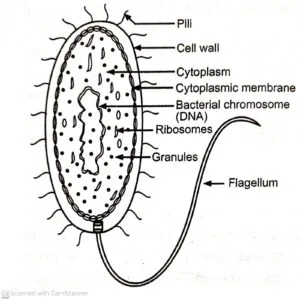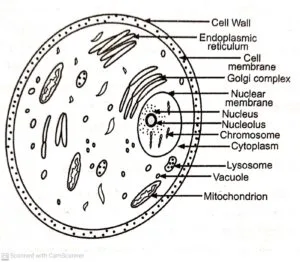Classified of Microorganisms
Taxonomy is the science that deals with the logical arrangement of living things into categories. Aristotle (4th Century B.C.) was probably the first to group all organisms and categorized them as either plants or animals.
In 1735, Carolus Linnaeus (Swedish botanist) named thousands of plants and animals and classified them into the Kingdoms Plantae and Animalia. He also devised the binomial (Genus and species) scheme of nomenclature.
Until the eighteenth century, the classification of living organisms was placed into two Kingdoms, Plant and Animal. The German Zoologist, E. H. Haeckel in 1866 proposed a third Kingdom ‘Protista’, to include those unicellular microorganisms that are typically neither plants nor animals.
Protista contains bacteria, algae, fungi, and protozoa but viruses are not classified as Protista (non-cellular organisms). Bacteria are classified as lower Protista and algae, and fungi and protozoa are classified as higher Protista.
Many biologists have accepted the system proposed by Robert H. Whittaker in 1969 for the classification of living organisms. He proposed that all living beings can be classified under five kingdoms based on the nutrition and absorption of food materials. The prokaryotic organisms are included under the kingdom monera (lower protista). These organisms do not have the ingestive mode of nutrition.
The unicellular eukaryotic microorganisms are placed in the kingdom Protista (higher Protista). In microalgae it is photosynthetic, in protozoa it is ingestive and in some other Protista, it is absorptive.
Whittaker explained that some organisms assimilate carbon dioxide using photosynthesis while some obtain it through nutrients absorbed from other organisms and some obtain organic nutrients by way of ingestion.
He classified plants, fungi, and animals into three separate kingdoms based on the mode of nutrition.
In the scheme of Whittaker. microorganisms are accommodated in three of the five kingdoms.
This system places all living things (except viruses) into five kingdoms based on cellular organization and nutritional patterns, the Monera, Protista, Fungi, Animalia, and Plantae.
Kingdom Monera includes all unicellular prokaryotes (eg bacteria, cyanobacteria) and Kingdom Protista includes unicellular eukaryotic cells (e.g. microalgae, protozoa). The multicellular and multinucleate eukaryotic organisms are found in the Kingdom Fungi, Kingdom Plantae, and Kingdom Animalia which mainly utilize nutrients by absorption, photosynthesis, and ingestion, respectively.
Viruses are acellular microorganisms that have neither cells nor cell membranes. They are composed of a few genes which are protected by a protein coat. Viruses act as dead components outside of the host but inside the host, they are alive and reproduce by utilizing the host cells.
Prokaryotes and Eukaryotes
All living organisms are made up of cells and it is the structural and functional unit of life. The cell was first discovered by Robert Hook (1665). Organisms that are made up of single cells are known as single-celled or unicellular organisms and many cells are known as multicellular organisms.
All organisms are classified into Prokaryotic (primitive nucleus) and Eukaryotic (true nucleus). These terms are first proposed by Edward Chatton (1937). Prokaryotic cell lacks membrane-bound organelles, such as a nucleus (Fig. 1.2). The bacteria and cyanobacteria have a prokaryotic cell while fungi, protozoa, algae, plants, and animals have eukaryotic cells.
Prokaryotic are simple, small cells while eukaryotic cells are complex, larger size single-celled, or multicellular. Differences in the cellular structure of prokaryotic and eukaryotes include the presence of mitochondria and chloroplasts, the cell wall, and the structure of chromosomal DNA (PHOTO prokaryotic cells)
The chromatin bodies remain scattered inside the cytoplasm or prokaryotes and asexual division occurs by binary fission. The chromatin bodies are enclosed by a nuclear membrane in a eukaryotic cell and cell division occurs by asexual as well as sexual division. The eukaryotic cells have a variety of membrane-bound components lacking in prokaryotes.
These components are called organelles which include the endoplasmic reticulum, Golgi bodies, lysosome, and mitochondria. Protein synthesis in eukaryotic cells is carried out on ribosomes associated with the endoplasmic reticulum, a network of internal membranes.
Golgi apparatus consists of a stack of many flattened, disc-shaped sacs known as cisternae. The main function of the endoplasmic reticulum and Golgi apparatus is the synthesis of lysosomes, which helps in the digestion of intracellular molecules.
The lysosome is the membrane-bound organelle found only in eukaryotic cells, which contains hydrolytic enzymes. Mitochondria are called as ‘powerhouse of the cell’ and it is responsible for making ATP by redox reactions. Chloroplasts are found in algae and plants and help in converting energy sunlight into chemical energy through photosynthesis. Both mitochondria and chloroplasts have their DNA and are capable of synthesizing particular proteins.
Cell walls and chloroplast are not found in animal cells. The eukaryotic cells possess a cytoskeleton, which is an interconnected system of fibers, threads, and interwoven molecules that render structure to the cell.


Both prokaryotes and eukaryotes contain ribosomes which plays major role in protein synthesis. Prokaryotic ribosomes (70S) are smaller than eukaryotic ribosomes (80s). The unit of measurement is the Svedberg (s) unit. In prokaryotes, there are 50s and 30s subunits of ribosomes, whereas in eukaryotic cells there are 60S and 40S subunits.
Prokaryotic ribosomes exist free in the cytoplasm, while eukaryotic ribosomes are usually bound to membranes of endoplasmic reticulum. Several prokaryotic and eukaryotic cells contain organells called flagella and cilia. Flagella are long, and hair like and extend from the cell to permit cell movement. Cilia are shorter but more in number than flagella.
The cell membrane lies at the surface of all cells and is composed primarily of proteins and lipids. Many prokaryotic and eukaryotic cells contain cell wall, a structure outside the cell membrane. Almost all bacteria have a thick, rigid cell walls; whereas eukaryotes, the algae, the fungi and plants have cell walls. Cell wall of fungi contains a polysaccharide called chitin while bacteria possess a different polysaccharide called peptidoglycan.
Prokaryotes contain only a single, circular loop of stable chromosomal DNA; while eukaryote DNA is linear, found on tightly bounded and organized chromosomes. Prokaryotes also differ from eukaryotes in the structure, packing, density and arrangement of their genes on the chromosome. Prokaryotes have compact genomes compared to eukaryotes because prokaryotes genes lack introns and large non-coding regions between each gene.
Classification of Bacteria
The Bergey’s Manual of Determinative Bacteriology published by Williams and Wilkins Co. Baltimore, U.S.A. (1974), is the international standard for bacterial taxonomy. I deals with the classification of bacteria (19 parts) and contains descriptions of all species known at the time of its publication.
Bergey’s manual was revised between 1984 and 1989 and appeared in four volumes with a new name as Bergey’s Manual of Systematic Bacteriology. In these four volumes, bacteria have been classified in 33 sections based on morphological and biochemical characteristics Bacterial groups are divided into four volumes.
Gram-negative bacteria (1984) of general, medical and industrial importance.
(ii) Gram-positive bacteria (1986) other than actinomycetes.
(iii) Gram-negative bacteria (1989) with distinctive properties, cyanobacteria and archaeobacteria and
(iv) Actinomycetes (1989) as Gram-positive filamentous bacteria.
The Bergey’s Manual of Systematic Bacteriology places all bacteria in the Kingdom Procaryotae which in turn is divided into four divisions which are as follows:
Kingdom Procaryotae
Division I: Gracilicutes (Thin skin): Prokaryotes with a complex cell wall structure characteristic of Gram-negative bacteria (e.g. non-photosynthetic bacteria).
Division II: Firmicutes (Strong skin): Prokaryotes with a cell wall structure characteristic of Gram-positive bacteria (e.g. rods, cocci, actinomycetes).
Division III: Tenericutes (Soft or tender skin): Prokaryotes that lack a cell wall (e.g. mycoplasma)
Division IV: Mendosicutes (Skin with faults): Prokaryotes with unusual cell walls
(e.g. archaeobacteria)
All bacteria are classified as kingdom, division, class, order, family, tribe, genus, section, series, species and individual. All microorganisms have a double name, usually from Latin or Greek stems. The name consists of the genus to which the organism belongs and a species modifier that further describes the genus name. Hence this system is called the binomial system e.g. Escherichia coli, Corynebacterium diphtheriae etc.
